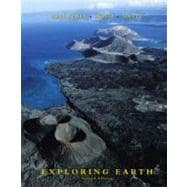
(NOTE: Each chapter begins with Overview and Introduction and concludes with Summary, Key Terms, and Questions for Review and Further Thought.)
I: PLANET EARTH: ACTING AND INTERACTING.
II: COMPOSITION AND TIME.
III: EARTH DYNAMICS.
IV: SHAPING OF EARTH.
V: EARTH AND ENVIRONMENT.
The New copy of this book will include any supplemental materials advertised. Please check the title of the book to determine if it should include any access cards, study guides, lab manuals, CDs, etc.
The Used, Rental and eBook copies of this book are not guaranteed to include any supplemental materials. Typically, only the book itself is included. This is true even if the title states it includes any access cards, study guides, lab manuals, CDs, etc.